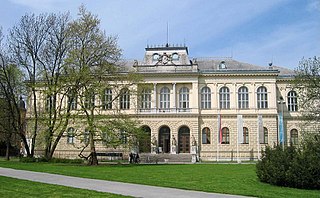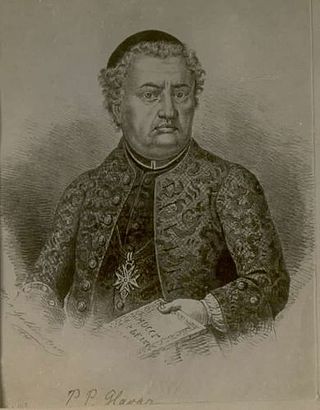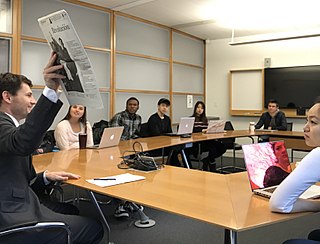
Ljubljana is the capital and largest city of Slovenia. It is the country's cultural, educational, economic, political and administrative center.

Sigmund Zois Freiherr von Edelstein, usually referred as Sigmund Zois was a Carniolan nobleman, natural scientist and patron of the arts. He is considered one of the most influential figures of the Enlightenment Era in the Slovene Lands of Habsburg Austria.

Prešeren Day, full name Prešeren Day, the Slovene Cultural Holiday, is a public holiday celebrated in Slovenia on 8 February. It is marking the anniversary of the death of the Slovene national poet France Prešeren on 8 February 1849 and is the celebration of the Slovenian culture. It was established in 1945 to raise the cultural consciousness and the self-confidence of the Slovene nation, and declared a work-free day in 1991. On February 7, the eve of the holiday, the Prešeren Awards and the Prešeren Fund Awards, the highest Slovenian recognitions for cultural achievements, are conferred. Prešeren Day continues to be one of the most widely celebrated Slovene holidays. During the holiday all state and municipal museums and galleries offer free entry, and various other cultural events are held. The holiday is celebrated not only in Slovenia, but also by Slovene communities all around the world.

The Kresija Building is a building that together with Philip Mansion marks the entrance to the old town of Ljubljana, the capital of Slovenia. It stands at the Adamič and Lunder Embankment on the right bank of the river Ljubljanica immediately after the Triple Bridge and borders Pogačar Square, Stritar Street, and Maček Street. Until 2007, the Ljubljana Center Administrative Unit was stationed in the building. Now, it houses a number of municipal offices, the Kresija Gallery, and the Ljubljana visitor centre.

Zois Mansion is a mansion in Ljubljana, the capital of Slovenia. It stands in the Center District, at Breg, a street on the west (left) bank of the Ljubljanica, between Teutonic Street to the north and Zois Street to the south. The mansion served as residence of Baron Sigmund Zois, a leading figure of Enlightenment in the Slovene Lands of the Austrian monarchy and supporter of the revival of Slovene culture and literature.

Ljubljana Town Hall is the town hall in Ljubljana, the capital of Slovenia, is the seat of the City Municipality of Ljubljana. It is located at Town Square in the city centre close to Ljubljana Cathedral.

The National Museum of Slovenia is located in Ljubljana, the capital of Slovenia. It is located in the Center district of the city near Tivoli City Park. Along with the Slovenian Museum of Natural History, located in the same building, the National Museum of Slovenia is the country's oldest scientific and cultural institution. The museum has an extensive collection of archaeological artefacts, old coins and banknotes and displays related to the applied arts. In 2021 it's been given the golden Order for Exceptional Merits by the president of Slovenia, Borut Pahor.

The Dragon Bridge is a road bridge located in Ljubljana, the capital of Slovenia. It crosses the Ljubljanica River. between Kopitar Street and Ressel Street, to the north of the Ljubljana Central Market at Vodnik Square. It was built in the beginning of the 20th century, when Ljubljana was part of the Austro-Hungarian Empire. As one of the best examples of reinforced concrete bridges and of the Vienna Secession style, the bridge is today protected as a technical monument. It is intended primarily for motorised traffic.

Edvard Ravnikar was a Slovenian architect.

Navje Memorial Park, the redesigned part of the former St. Christopher's Cemetery, is a memorial park in Ljubljana, the capital of Slovenia. It is located in the Bežigrad district, just behind the Ljubljana railway station.

Stara Vrhnika is a village north of Vrhnika in the Inner Carniola region of Slovenia. It includes the hamlets of Kuren, Podčelo, and Razor.
Bukovska Vas is a settlement on the left bank of the Mislinja River in the Municipality of Dravograd in the Carinthia region in northern Slovenia. It includes the hamlet of Sveta Jedrt.

The Vače Situla is an ornamented Early Iron Age ritual bronze vessel (situla) found in the second half of the 19th century at the Hallstatt Archaeological Site in Vače in central Slovenia. It counts among the highest-quality such vessels in general and among the most precious archeological artifacts of the country. Dating from the 5th century BC, it is considered to be one of the oldest situla objects of the northern Illyrians found in the Eastern Hallstatt zone. The vessel has three rows of relief that show the ordinary life of the ruling class and also reflect the religious understanding of the world in that time. It is on display in the National Museum of Slovenia.

Sts. Cyril and Methodius Church, commonly known as the Orthodox Church, is an Eastern Orthodox church building located in Trubar Park, between Bleiweis Street and Prešeren Street, north of the Museum of Modern Art and west of the National Gallery of Slovenia. It belongs to the Metropolitanate of Zagreb and Ljubljana of the Serbian Orthodox Church.

Tivoli Pond is a man-made pond at the southeastern end of Tivoli City Park in Ljubljana, the capital of Slovenia. It was created in 1880. It is part of Tivoli–Rožnik Hill–Šiška Hill Landscape Park and has been used for recreation, fishing, and as a flood-control reservoir. The pond is administered by the Barje Fishing Club. It has been home to a variety of native and non-native animal species and it has served as a theme and a scene for visual artists and musicians.

The Prešeren Monument in Ljubljana, also Prešeren Statue in Ljubljana, is a late Historicist bronze statue of the Slovene national poet France Prešeren in Ljubljana, the capital of Slovenia. It stands in the eastern side of Prešeren Square, in front of the Central Pharmacy Building in Ljubljana, the capital of Slovenia. It is among the best-known Slovenian monuments.

Peter Pavel Glavar was a Carniolan Roman Catholic priest, beekeeper, writer, and businessman.
Gradec is a remote abandoned settlement in the Municipality of Črnomelj in the White Carniola area of southeastern Slovenia. The area is part of the traditional region of Lower Carniola and is now included in the Southeast Slovenia Statistical Region. Its territory is now part of the village of Rožič Vrh.

Jurij Toplak is a constitutional scholar, university administrator, election law, and human rights expert. He is a recurring visiting professor at the Fordham University School of Law in New York. From 2016 to 2022 he served as the provost of the Alma Mater Europaea university. The Washington Post, The Guardian, The Wall Street Journal, Financial Times, The New York Times, and The Boston Globe published his legal comments. He serves as the co-chair of the International Association of Constitutional Law (IACL) Freedom of Expression research group. Toplak is a member of the European Academy of Sciences and Arts.
Prispevki za novejšo zgodovino is a peer-reviewed academic journal covering the contemporary history. It is published by the Institute of Contemporary History, Slovenia, based in Ljubljana and the editor-in-chief is Jure Gašparič. The journal was established in 1960 as Prispevki za zgodovino delavskega gibanja and in 1980, it was renamed to Prispevki za novejšo zgodovino.

















